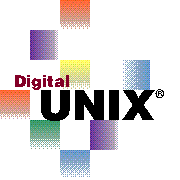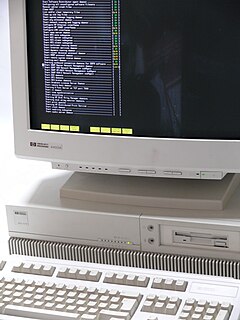Related Research Articles

vi is a screen-oriented text editor originally created for the Unix operating system. The portable subset of the behavior of vi and programs based on it, and the ex editor language supported within these programs, is described by the Single Unix Specification and POSIX.

The X Window System is a windowing system for bitmap displays, common on Unix-like operating systems.

XFree86 is an implementation of the X Window System. It was originally written for Unix-like operating systems on IBM PC compatibles and was available for many other operating systems and platforms. It is free and open source software under the XFree86 License version 1.1. It was developed by the XFree86 Project, Inc. The lead developer was David Dawes. The last released version was 4.8.0, released December 2008. The last XFree86 CVS commit was made on May 18, 2009; the project was confirmed dormant in December 2011.

Tru64 UNIX is a discontinued 64-bit UNIX operating system for the Alpha instruction set architecture (ISA), currently owned by Hewlett-Packard (HP). Previously, Tru64 UNIX was a product of Compaq, and before that, Digital Equipment Corporation (DEC), where it was known as Digital UNIX.

Xenix is a discontinued version of the Unix operating system for various microcomputer platforms, licensed by Microsoft from AT&T Corporation in the late 1970s. The Santa Cruz Operation (SCO) later acquired exclusive rights to the software, and eventually replaced it with SCO UNIX.
Almquist shell is a lightweight Unix shell originally written by Kenneth Almquist in the late 1980s. Initially a clone of the System V.4 variant of the Bourne shell, it replaced the original Bourne shell in the BSD versions of Unix released in the early 1990s.
In the Unix operating system, shar is an archive format created with the Unix shar utility. A shar file is a type of self-extracting archive, because it is a valid shell script, and executing it will recreate the files. To extract the files, only the standard Unix Bourne shell sh is usually required.

Coherent is a clone of the Unix operating system for IBM PC compatibles and other microcomputers, developed and sold by the now-defunct Mark Williams Company (MWC). Historically, the operating system was a proprietary product, but it became open source in 2015, released under the BSD-3-Clause license.
Accelerated-X is a proprietary port of the X Window System to Intel x86 machines.
X.Org Server is the free and open-source implementation of the X Window System display server stewarded by the X.Org Foundation.

Unix System V is one of the first commercial versions of the Unix operating system. It was originally developed by AT&T and first released in 1983. Four major versions of System V were released, numbered 1, 2, 3, and 4. System V Release 4 (SVR4) was commercially the most successful version, being the result of an effort, marketed as Unix System Unification, which solicited the collaboration of the major Unix vendors. It was the source of several common commercial Unix features. System V is sometimes abbreviated to SysV.

Windows NT 3.1 is the first major release of the Windows NT operating system developed by Microsoft, released on July 27, 1993 and oriented towards businesses.

Multiuser DOS is a real-time multi-user multi-tasking operating system for IBM PC-compatible microcomputers.

Elvis is an enhanced clone of the vi text editor, first released in January 1990. It introduced several new features, including syntax highlighting and built-in support for viewing nroff and HTML documents. Elvis is written by Steve Kirkendall and is distributed under the Clarified Artistic License (ClArtistic) which is used by Perl and is a GPL-compatible free software license.
Berkeley Yacc (byacc) is a Unix parser generator designed to be compatible with Yacc. It was originally written by Robert Corbett and released in 1989. Due to its liberal license and because it was faster than the AT&T Yacc, it quickly became the most popular version of Yacc. It has the advantages of being written in ANSI C89 and being public domain software.

The Tanenbaum–Torvalds debate was a written debate between Andrew S. Tanenbaum and Linus Torvalds, regarding the Linux kernel and kernel architecture in general. Tanenbaum, the creator of Minix, began the debate in 1992 on the Usenet discussion group comp.os.minix, arguing that microkernels are superior to monolithic kernels and therefore Linux was, even in 1992, obsolete. The debate has sometimes been considered a flame war.

Xconq is an open-source computer strategy game. First posted to comp.sources.games on 9 July 1987, it is notable as one of the first multiplayer video games to be released for the X Window System. It was for several years the only turn-based graphical war game available on Unix/X systems. Xconq is released as free and open-source software under the terms of the GNU GPL-2.0-or-later.
Linux began in 1991 as a personal project by Finnish student Linus Torvalds: to create a new free operating system kernel. The resulting Linux kernel has been marked by constant growth throughout its history. Since the initial release of its source code in 1991, it has grown from a small number of C files under a license prohibiting commercial distribution to the 4.15 version in 2018 with more than 23.3 million lines of source code, not counting comments, under the GNU General Public License v2.
Ralf Brown's Interrupt List is a comprehensive list of interrupts, calls, hooks, interfaces, data structures, CMOS settings, memory and port addresses, as well as processor opcodes and special function registers for x86 machines from the very start of the PC era in 1981 up to 2000, most of it still applying to PCs today.

DOS is a platform-independent acronym for disk operating system which later became a common shorthand for disk-based operating systems on IBM PC compatibles. DOS primarily consists of Microsoft's MS-DOS and a rebranded version under the name IBM PC DOS, both of which were introduced in 1981. Later compatible systems from other manufacturers include DR DOS (1988), ROM-DOS (1989), PTS-DOS (1993), and FreeDOS (1998). MS-DOS dominated the IBM PC compatible market between 1981 and 1995.
References
- ↑ Thomas Roell (1991-02-11). "X386 1.1". Newsgroup: comp.archives. Usenet: 1991Feb11.192043.27202@ox.com . Retrieved 2008-02-29.
- ↑ david.e.wexelblat (1992-09-03). "X386 1.2E is changing its name to XFree86". Newsgroup: comp.unix.bsd. Usenet: 1992Sep3.160121.18696@cbnewsj.cb.att.com . Retrieved 2008-02-29.
